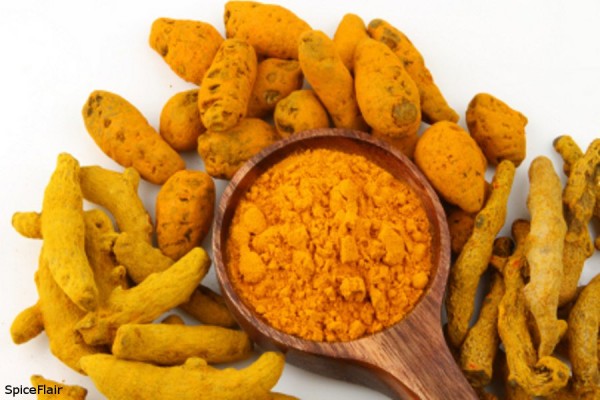
Advertisement
Those looking to add turmeric (Curcuma longa) to their diets would be better off using fresh roots and freeze-dried powders if they want optimal nutrition, instead of getting the sun-dried versions from the health food stores.
According to researchers from Mahasarakham University in Thailand, this is because standard drying methods could cause severe reductions in the herb’s chemical components, thereby lessening its healing properties.
As published in the journal Food Chemistry, the research team investigated the effects of several standard drying methods on the chemical components and microstructure of turmeric. The drying methods were freeze-drying, hot-air drying at 50 °C and sun-drying — all of which are used in the production of powdered supplements.
What they found was that all drying methods resulted in reductions in turmeric’s natural chemical components such as curcuminoids, phenolic acids, flavonoids and amino acids.
For instance, sun drying caused a severe decline of three major curcuminoids — a direct result of UV and light degradation.
Among the methods tested, sun drying resulted in the greatest reductions in the herb’s curcumin content, decreasing it by 72 percent. This was followed by hot-air drying and freeze-drying, which logged the lowest levels of reductions at 61 and 55 percent, respectively. The herb’s amino acids were also reduced by all the drying methods.
According to the researchers, freeze-drying was the most suitable for drying turmeric, as it had the least effects on the herb’s microstructure changes. This, the researchers noted, meant that freeze-dried turmeric can easily be used as a substitute for fresh roots.
That said, the researchers stated fresh turmeric is still the best, as its natural components are all still intact, thereby making it a potent addition to any diet.
Turmeric: A nutrient powerhouse
Turmeric is a flowering plant native to the region of South Asia. A member of the ginger family, this herb plays an integral part, not just in Indian cuisine, but also, in several ancient medical practices such as Ayurveda. In the latter, it is considered to be effective against ailments such as ulcers, gastrointestinal ailments and complications, skin diseases, anemia, diabetes and rheumatism.
Turmeric is also predominantly featured in traditional Chinese medicine or TCM, where it is used to treat amenorrhea or the absence of menstrual periods as well as chronic inflammation and chronic pain.
Research shows that turmeric owes much of its beneficial effects to a particular group of phytochemical compounds called curcuminoids. These are the same group of phytochemicals that give turmeric its distinctive golden and tawny color, as well as its biting flavor.
Aside from being rich in phytochemicals, turmeric is also quite an impressive source of vitamins such as vitamins C and B, as well as essential minerals such as calcium, manganese, iron, potassium and zinc — all of which are known to help support good overall health.
Because of its impressive nutrient stores, it’s not surprising to learn that turmeric has been linked to the following health benefits:
Turmeric can help stop oxidative damage
Research shows that turmeric can effectively stop oxidative damage. This is due to its curcumin content which has been proven to be extremely effective against the actions of free radicals.
Curcumin works in two ways: first, by blocking free radicals directly; second, by stimulating the body to produce its own antioxidant enzymes.
Turmeric can help stave off cancer
Researchers at the Industrial Toxicology Research Centre in India have found that turmeric, once brewed with the equally potent ginger, can help protect the body against certain forms of cancer. This has been attributed to compounds like vallinoids, zingerone, shogaols, gingerols and paradols that can help ward off the development of cancerous growths.
Turmeric can help protect the body against chronic illnesses
According to a study published in the journal Foods, turmeric and its main active ingredient curcumin are incredibly effective when it comes to combating inflammation in the body. This means that turmeric can help stave off the development of chronic diseases such as asthma, metabolic syndrome, cardiovascular disease, psoriasis and Type 2 diabetes — all of which are linked to uncontrolled, chronic inflammation.
How to use freeze-dried turmeric
Freeze-dried turmeric powder can be used as a direct replacement for fresh turmeric, since it is the processed variant that is least damaged, compared to the sun-dried varieties.
Experts recommend consuming a teaspoon or roughly 5 grams of the potent golden spice per day, in order to experience its array of health benefits.
While it can be easily added to foods such as curries and stews, and even brewed as a tea, many point to smoothies as an ideal way for beginners to acquaint themselves with turmeric, as its sweet ingredients can easily mask the spice’s distinct, earthy and biting taste.
Once one gets well-acquainted with turmeric’s flavor, he or she can try taking it in other, more savory or spicy ways.
With that said, here’s a recipe for a refreshing golden smoothie, made from organic mangoes, kefir and turmeric:
Ingredients:
- 1 cup organic mango cubes (fresh or frozen)
- 1/4 cup organic oats (old fashioned rolled or quick)
- 1/4 cup non-fat plain organic Greek yogurt
- 1/2 teaspoon organic ginger
- 1/2 teaspoon organic freeze-dried turmeric OR ½ teaspoon minced, organic fresh turmeric
- 1/4 cup kefir
- 1/4 teaspoon black pepper
- 4 to 5 ice cubes (if using fresh organic mangoes)
- Raw manuka honey OR organic maple syrup, to taste
- Optional: organic chia or hemp seeds
Preparation
- Blend all ingredients except chia and hemp seeds in a high-powered blender.
- Pour smoothie into a glass.
- Sprinkle chia or hemp seeds as a topping.
- Enjoy!
Turmeric is one of the most potent and powerful spices one can add to his diet. Not only is it packed full of essential vitamins and minerals, but it is also rich in health-supporting antioxidants and other compounds linked to optimal health and wellness.
While fresh roots are always the best way to get your fill of this powerful spice, in case those aren’t available, one can always make do with the freeze-dried variety.
One should note, however, that curcumin, despite its potency, has poor bioavailability, which means it is not readily absorbed by the body. To get around this, make sure you pair turmeric with some black pepper. This is because black pepper contains a compound called piperine, which can enhance your body’s absorption of curcumin.
Sources:
Advertisements







